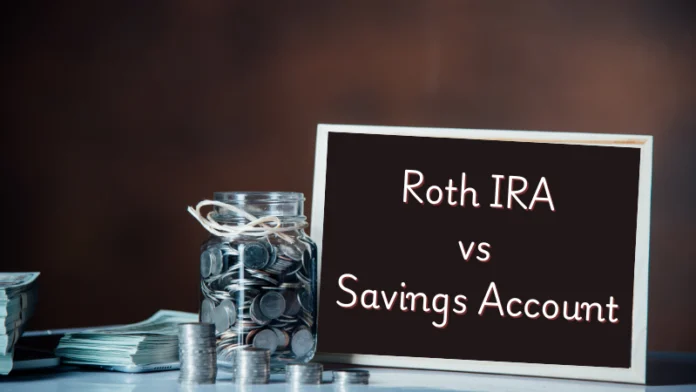Table of Contents
Having a hard time making a decision between a Roth IRA vs Savings Account, which one will make a hit? You’ve rolled your eyes in the right spot. Both options can make a spot depending on your financial goals and requirements, or you can open an account in each one of them; how about this?
So come over and learn in-depth about Roth IRA vs savings Account, and understand which fits the bill for you! But hold on! Before making a comparison between a savings account and a Roth IRA, let’s learn about what savings and Roth IRA accounts are first, plus what their pros and cons are before making the final call.
Let’s start with a Savings Account first!
What is a Savings Account?
In simple words, a savings account is a bank account type designed to save money that you don’t plan to spend right away and is especially suitable for achieving short-term financial goals.
Similar to checking accounts, you can access your money and make withdrawals as required. However, with savings accounts, the bank pays you CI (Compound Interest) for parking funds in your account.
Pros and Cons of Savings Accounts
Firstly, we’ll glance at the advantages:
Pros of Savings Account
Simple & Quick
Holding money in savings accounts at the same financial institutions where your primary checking account is, can prove beneficial. The transfer of money between the accounts at the same institution generally takes less time. Also, the deposits or withdrawals done to your savings account from your checking account will be fast.
Hassle-Free Linking to your Primary Checking Account
When you link your savings account to your primary checking account, it results in an easy transfer of surplus cash from your checking account, and access to it immediately contributes to earning interest. Alternatively, you can transfer money if you want to make a large checking transaction.
Due to the interest, it is sensible to keep unneeded or extra funds in a savings account instead of holding that in your checking account, as a checking account makes you earn less or no interest.
You Can Anytime Withdraw the Full Balance
Liquidity remains flawless when you have access to funds in a savings account, unlike CDs (Certificate of Deposits), which charge a hefty penalty if you make an early withdrawal of funds.
Earn Up to $250,000 is Federally Insured Against Any Bank Failure
You get federal protection to hold money in savings accounts against bank failures offered by the FDIC (Federal Deposit Insurance Corporation) that will keep your money safe.
Maintaining a Minimum Balance is Fruitful
Several banks offer interest rates ranging from 2.70% on savings bank accounts. However, a few banks offer you a higher interest rate up to 7.50% if you’re able to maintain the minimum balance in your savings account.
Do you know you can get higher interest on your savings account? Read this guide on How to Get Higher Interest Rates on Savings account.
Cons of Saving Accounts
Pays Less Interest
You’ll have a lesser rate of interest in savings accounts compared to Treasury bills, investing in bonds and stocks, plus CDs (Certificate of Deposits), which offer a higher rate of interest. The interest rates of these accounts are only beneficial if you’ve a longer time horizon.
Tempting Withdrawals
The instant availability of funds may give you the access to spend more than what you’ve saved.
A Few Accounts Require Minimum Balances
Specific savings accounts ask for a minimum balance to avoid any monthly charges or earn the highest published rate or interest rate.
List of Some Best Savings Accounts
| S.No. | Bank Name | APY (%) | Minimum Balance Requirement for API ($) |
| 1. | My Banking Direct | 5.35 | 500 |
| 2. | Vio Bank | 5.30 | 100 |
| 3. | EverBank | 5.05 | 0 |
| 4. | UFB Direct Savings Account | 5.15 | 0 |
| 5. | Popular Direct High-yield Savings Account | 5.05 | 100 |
| 6. | BrioDirect | 5.30 | 5000 |
| 7. | BMO Savings Account | 5.10 | 0 |
| 8. | Poppy Bank | 5.50 | 1000 |
| 9. | Ivy Bank | 5.30 | 10 |
| 10. | Forbright Savings Account | 5.30 | 0 |
| 11. | TAB Savings Account | 5.27 | 0 |
| 12. | Jenius Bank Savings Account | 5.25 | 0 |
*Important Note:
- The rates listed above are current as of August 2024 and are not subject to change.
- The APY of these online savings accounts is more than 5%.
What is a Roth IRA Account?
A Roth IRA is an Individual Retirement Account that helps you save dollars left after tax. These after-tax dollars play an important role in saving for your retirement.
Moreover, you can withdraw your contributions without incurring penalties or taxes. People aged 59 1⁄2 or above who’ve held their Roth IRA accounts for at least five years have the benefit of withdrawing their earnings and contributions without any penalty or tax.
Pros and Cons of Roth IRA Account
Pros of Roth IRAs
A Roth IRA is brimmed with several benefits, and below you’ll see how:
Hurray for a Tax-Free Rise in Your Savings
When you retire and withdraw from a Roth IRA, what advantage do you get? Well, you don’t need to pay taxes on them. This covers both the contributions plus the earnings on all your contributions. So, it helps in growing your savings and can be a huge benefit if you fall under a higher tax bracket in retirement.
Withdrawals Without Penalty is a Bliss
In case you require money for an unplanned reason, you can withdraw contributions anytime, which is your actual money (but not earnings that you get with interest) without incurring a penalty. Thus, a Roth IRA can be your backup emergency fund from which you can withdraw tax-free money.
Tax-Free Withdrawals for Beneficiaries
Unfortunately, if a retiree passes away, beneficiaries can easily inherit the IRA account, and the best part is that beneficiaries can still make tax-free withdrawals.
*Pro Tip: Make sure you don’t indulge deeper into it and make it a regular habit!
No Required Minimum Distributions (RMDs)
If you have a traditional IRA, people reaching age 72 or above must begin withdrawing money, and the credit goes to RMD (Required Minimum Distributions). However, in a Roth IRA, there are no RMDs, and hence, you only need to make withdrawals at the time you live. This makes the Roth IRA a great source of money that you can pass on to your beneficiaries or successors.
*Important Note: Make sure that your beneficiaries should take RMDs after you die.
No Age Limitation
Roth IRAs have no age limit. Account holders can conveniently make contributions as long as they’re earning income. Lesser limitations give account holders the freedom to enjoy that extra flexibility in managing their retirement accounts.
No Boundations by the Employer’s Plan
Any individual within the income limit can make contributions to a Roth IRA up to the maximum annual amount. The terms of the employer’s plan do not restrict these contributions.
Cons of Roth IRAs
Early Withdrawals Means No Exit Road:
Early withdrawal of contributions isn’t a wise move, or you can say it’s a dead-end street! In a Roth IRA, you don’t get a chance to make any extra contributions in the upcoming years to make up for the money you have taken out.
Income Restriction
People with higher MAGI (Modified Adjusted Gross Income) can’t avail themselves of the advantages of Roth IRAs as the contributions they make are restricted by the account owner’s income. Individuals can’t make contributions with the income they hold if it’s higher than the limit set by the IRS based on the owner’s MAGI.
To simplify your confusion, we’ve got you covered with some of the best pics for Roth IRA Accounts.
Overall Best Roth IRA Accounts
| S. No. | Provider | Best Known for | Commission | Minimum Amount to Open ($) |
| 1. | Charles Schwab | Investor Education | $0 | 0 |
| 2. | Betterment | Automated Investing With Access to Human Advice | Management fee: 0.25 – 0.40 percent of assets annually | 0 |
| 3. | Fidelity Investments (Overall Best) | Active Investors Seeking Full-Service Brokerage Features | $0 | 0 |
| 4. | Interactive Brokers | Wide Range of Global Assets | $1 minimum/$0 with IBKR Lite | 0 |
| 5. | Wealthfront | Truly Hands-Off Approach to Investing | Management fee: 0.25 percent of assets annually | 500 |
| 6. | Vanguard | Access to Low Cost Mutual Funds | $0 | 0 |
| 7. | Merrill Edge | Existing Bank of America customers | $0 | 0 |
| 8. | E*TRADE | Mobile Investors | No commission for stock, mutual fund, and ETF. Options are $0.50-$0.65 per contract, depending on trading volume. | 0 |
| 9. | M1 Finance | Active Investors Seeking Automated Tools | 0%; $36 per year for M1 Plus ($3/month, 3 months free for new users) | $100 ($500 minimum for retirement accounts) |
*Important Note: The rates listed above are as of current August 2024 and are subject to change.
Best Roth IRA Picks for Online Brokers
| S.No. | Best Known For | Roth IRA Type |
| 1. | Overall Best Roth IRA (save for college education, retirement, or new home) | Fidelity Investments |
| 2 | Low costs investments, such as Mutual funds | Vanguard |
| 3. | Active investors looking for automated tools | M1 Finance |
| 4. | Large selection of trading platforms | Charles Schwab |
| 5. | Matching contributions | Robinhood |
| 6. | Active traders | Interactive Brokers |
| 7. | Mobile App | E*TRADE |
| 8. | Broad range of global assets | Interactive Brokers |
| 9. | Automated investing with access to human advice | Betterment |
| 10. | In-person customer support | P. Morgan Self-Directed Investing & Merrill Edge |
| 11. | Hands-Off Approach to Investing | Wealthfront |
| 12. | Investor Education | Charles Schwab |
Top Picks for Robo-Advisors:
| S.No. | Best Known For | Roth IRA Type |
| 1. | Overall Roth IRA | Charles Schwab Intelligent Portfolios |
| 2. | Matching contributions | SoFi Automated Investing |
| 3. | Low costs | Vanguard Digital Advisor |
| 4. | Portfolio options/investment selection | Wealthfront |
| 5. | Access to financial advisors | Betterment |
| 6. | Women investors | Ellevest |
Key Differences Between Savings Account Vs Roth IRA
| S.No. | Category | Savings Account | Roth IRA |
| 1. | Account Type | There’s no restriction on the amount of money you can hold in your savings account. | Savings accounts help people by offering easy and quick access to their money. |
| 2. | Contribution Limit | There’s no restriction to the amount of money you can hold in your savings account. | A Roth IRA is made exclusively for people who want to save for retirement. Sa |
| 3. | Investment Options | A savings account isn’t an “investment account”. | This account isn’t an investment or something but a type of account that holds investments, including bonds, stocks, and mutual funds. |
| 4. | Returns | Roth Investment Retirement Account earns income on investments it makes. The account balance will witness a seesaw effect as earnings are influenced by several economic factors and changes in the competitive stock market. | Roth Investment Retirement Account earns income on investments it makes. The account balance will witness a seesaw effect as earnings are influenced by several economic factors and changes with the competitive stock market. |
| 5. | Taxes | Whatever interest you earn in your savings account is considered taxable income. | This account type has specific tax rules with age limitations, etc. |
The Final Showdown
Whenever a pendulum is running inside your head, thinking which one is right for you between a Roth IRA and a savings account, you can pen down your different savings goals whether you require regular access to your money or are fine with limited access to your funds.
Make a note that these are two exceptionally different account types, and each account serves a particular purpose.
Need frequent access? Go for a Savings Account! And if you’re in no hurry to withdraw cash anytime soon, hands down, it’s a Roth IRA!
We hope you’ve got your answer so till then –
Happy Savings!



